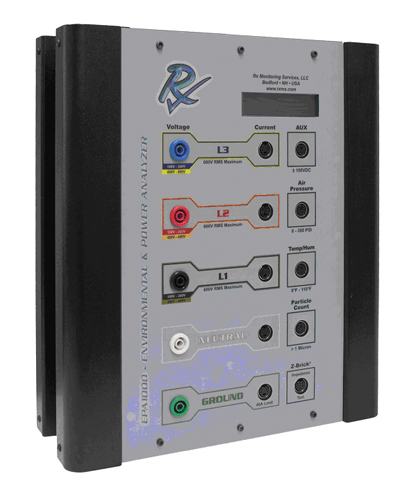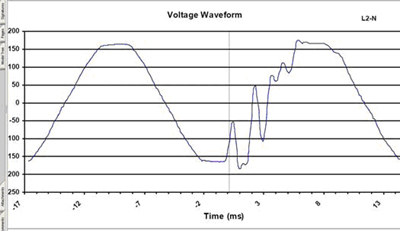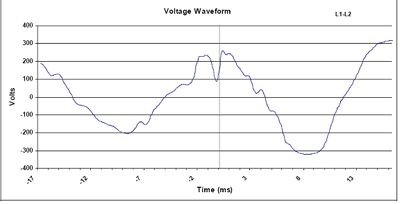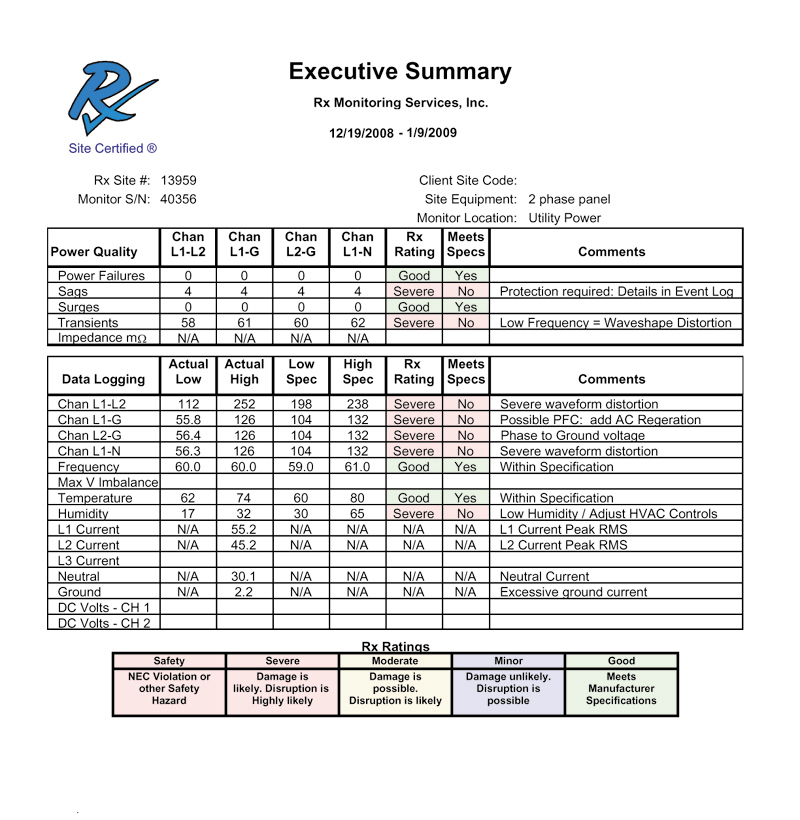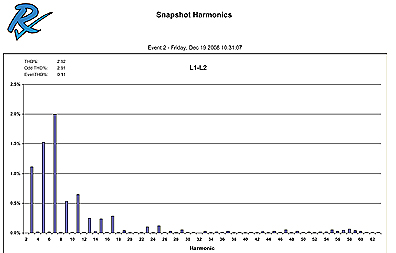
|
|
|
Section I: The Case For On-site AC Regeneration Canadian
manufacturer PurePower opened it's doors 5 years ago with a unique idea.
Instead of simply putting a band-aide on dirty, unstable power from
the local power utility, as virtually all the other power conditioners
did, they would throw it out and start from scratch, create brand new
electricity "isolated from the grid". |
|
|
This idea, to "regenerate" new electricity was nothing
new to them. As power quality
management experts in the commercial and industrial sectors, they knew
first hand that hospitals, labs, and precision manufacturers worldwide
need battery-grade reference power, de-coupled from the local power
company, running perfectly 24/7/365. When the electricity must be perfect, on-site regeneration is the
solution. PurePower
was born to meet that need for audiophiles and videophiles whose
investment in their AV systems justifies the same kind of effort and cost. The
specifications for the electricity we use in our homes and business's is
meant to serve the greatest number of consumers, or as the Public Utility
Commission calls it, "the greater good". It might be fine for running our refrigerators, toasters, air
conditioning, lighting, and computers, however, recent tests by Rx
Monitoring of Bedford, New Hampshire, a company that measures power
quality for large commercial entities as well as consumers, proves without
a doubt that the utility supplied AC is not close to being good enough to
operate today's high-end audio video systems. A
recent customer in New Jersey, who owns a large, expensive AV system
housed in multiple racks, experienced repeated shut-downs. At first glance, if the circuit breaker is tripping,
the usual solution is to increase the amperage, for example from 15 amps
to 20 amps, to get more power.
The consumer installed dedicated 20 amp circuits but the shut-downs
continued. Clearly,
further study was required and that's where Rx Monitoring entered the
picture, by referral from our local dealer, Bravo AV.
"The
following waveform has a nice clean sine wave on the left side
...but
the right side of the waveform is highly distorted. No |
many components have dozens of these in a circuit, some diodes will
turn on at the wrong time instead of in sequence. This causes the component to reverse bias and degrade (or
eventually blow-up) due to excessive heat. The "false" zero crossing also causes "timing"
issues and many circuits use the 60Hz sine wave to time the turn-on of
components (in a closed feedback loop) and these false crossings would
cause random errors and resets"
"The
waveform above shows multiple times that the sine wave had this low
frequency distortion that causes high-end electronics problems. This
waveform requires a "double-conversion AC regenerator" to
rebuild a new sine wave. It
is caused by the Utility turning on Power Factor Correction (PFC)
capacitors that are a required part of the electrical distribution system.
The waveform that it causes is allowed by the Public Utility
Commission (PUC) as the "greater good" for the most people and
in their opinion any device that is vulnerable to it would require a
"customer" provided solution." The capacitors are causing the transients at times of peak demand. Below
is an example of a momentary sag, also common on a residential circuit.
Lasting less than 8 milliseconds (one-half a cycle) this waveform
distortion also requires AC regeneration for total system performance. "Overall,
the power quality was not found to be conducive to powering high-end audio
visual equipment and distortion, degradation and eventual damage to the
equipment is possible. Most
importantly, the quality of the signal will be affected and that can
compromise the sonic and video quality.
Our engineers have evaluated the PurePower AC double conversion
regeneration device and the specs
indicate that it will be audibly quiet, provide the correct level of power
regeneration and provide quality and protection." |
|
|
|
|
Section II - What's In Your Wall Outlet?
|
|
| Above is a chart from the RX report that summarizes the results of the 21 day monitoring of the Utility supplied AC power at customer's Home. Note that during the monitoring period the voltage varied from a low of 112 volts to a high of 252. There were literally hundreds of sags, transient and power distortion "events" captured - and each one was recorded and graphed in the preparation of this very extensive and detailed report. | In
the summary chart the severity and significance of the power problems
are rated with a color key from severe to acceptable.
Below is the log form a single day - December 22. It is clear the utility was not providing our customer with a Christmas present of good power quality. |
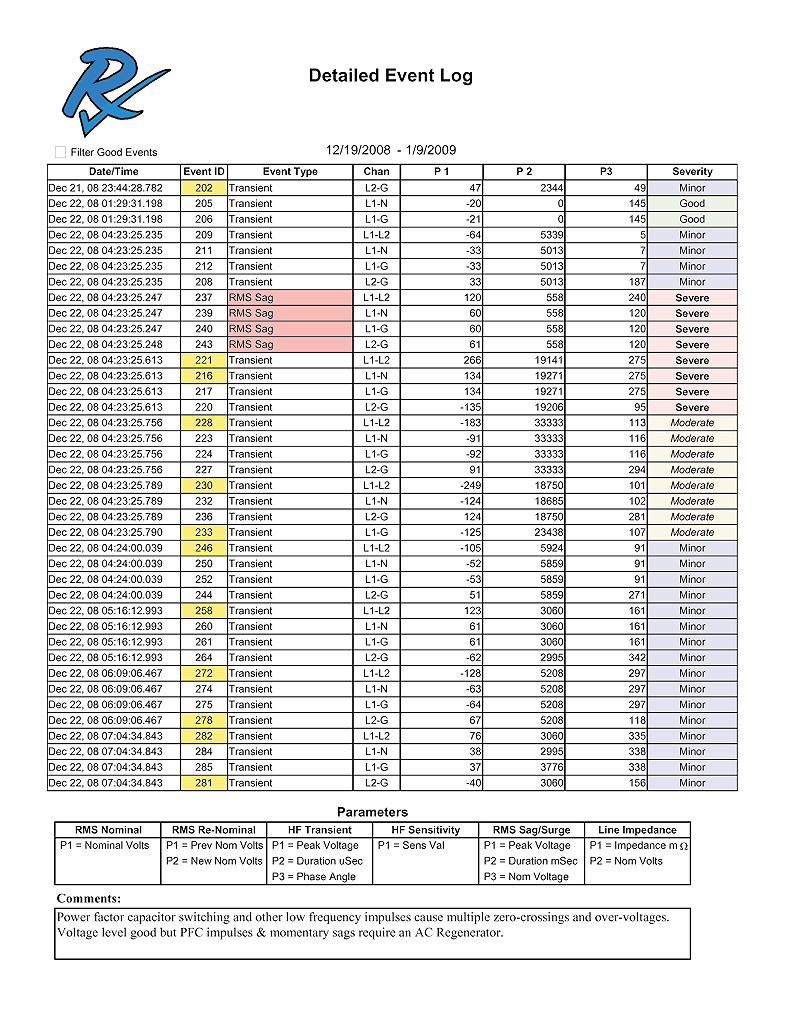 |
|

|
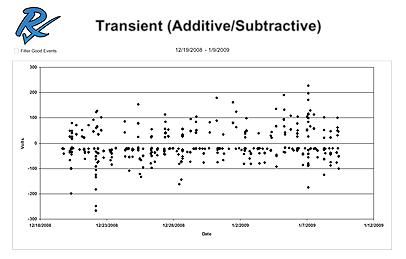 |
| Above is a chart summarizing some of the different voltage sag types captured during the monitoring study. Notice how the left hand side of the chart is in percent of voltage (either 120V or 240V). The Red area is very bad and the farther to the right the "dots" are, the longer in duration (time) of the sag. The longer the voltage events, the more damage can occur. It should be noted that this chart illustrates sag events unacceptable for high-end electronics. But the Utility finds it acceptable to deliver power of this grade. The Utility measures things in minutes while electronics measure things in picoseconds {A picosecond is one trillionth of a second (0.000000 000 001 seconds)}. | The
transient chart clearly indicates the threat posed by these short
(many are in the nanosecond range) voltage events. They are scattered
throughout the test period and many are greater than 200 volts above
or below nominal.
Their short duration means they don't pack the power of a major surge event - and they go unnoticed by the homeowner since they do not cause lights to flicker. However, they can do serious damage and even explosive failure to high power transistors and other sensitive solid state electronics.
|

Above is the voltage data log for a 24 hour period. Note how the voltage vacillates constantly from minute to minute and and hour to hour. It is also clear that the utility voltage at midnight is significantly higher than at 7 pm, hence the familiar audiophile comment that the system always sounds better at midnight. This is a typical day except for the very dramatic voltage drop in the early AM.
Section III - Why On-Site AC Regeneration is required.
|
|
| The efficacy of on-site AC regeneration in redressing the power quality problems associated with Utility delivered AC power can be easily demonstrated. When AC power with distortion, noise, voltage instabilities, sags, power outages and even unstable frequency is used as the source power supply for a PurePower double conversion AC regenerator the result is dramatic. The output of the regenerator is pure power with a new, clean, stable voltage sine wave. | It
doesn't matter how distorted the input - the output is always the
same. It is a complete solution.
Other Power conditioning technologies can ameliorate one problem or another - but never completely remove it. AC regeneration has been the preferred power quality solution in high tech, scientific and sensitive electronic installations for a number of years. Now there is an AC regenerator designed specifically for High end Audio and Video.
|
| Bad Power
in
|
Clean
power out
|
| Highly
Distorted Power in
|
Low
distortion out
|
|
From
company headquarters in the historic city of Cambridge Ontario, company
founder and president Damian Janzen said "Owner's of high end AV
gear know their systems can't reach their full performance potential if
the inbound power is unstable, noisy, and distorted. PurePower products convert the inbound AC from the local service
provider to DC, removing all the noise and distortion in the process,
before creating a brand new AC voltage sine wave, augmented by it's own
internal battery system. The battery system provides total isolation from the local power
grid, so that the very common voltage sags, surges, and transients can't
affect the AV system, even in a blackout".
For technical specifications and a more detailed explanation of AC regeneration technology, visit www.purepoweraps.com and read the technology pages.
|
If
you own a high performance system, and suspect your AC power is degraded,
PurePower has the solution you have been searching for.
If you already know you have problems, you can simply go to www.purepoweraps.com/Audit.htm and tell us about your system. We will provide a free Power Audit to help you choose the correct AC Regenerator. If you are unsure of your AC power - and you want the world's most definitive Home power quality analysis - just email sales@purepoweraps.com and ask about PurePower's brand new on site power quality audit. We can arrange a sophisticated engineer supervised PQ monitoring program just like the one described in this white paper. It is the definitive analysis of your utility power. |
|
|
|
|
|
|
|
_______________________________________ |
|
